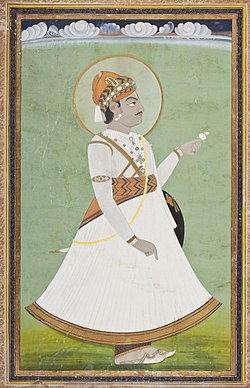Pratap Singh of Jaipur: Difference between revisions
(Minor grammatical correction.) |
(robot: Update article (please report if you notice any mistake or error in this edit)) |
||
| Line 1: | Line 1: | ||
{{Short description|Maharaja of Jaipur from 1778–1803}} | |||
{{Other people|Pratap Singh|Pratap Singh (disambiguation){{!}}Pratap Singh}} | {{Other people|Pratap Singh|Pratap Singh (disambiguation){{!}}Pratap Singh}} | ||
{{More citations needed|date=December 2009}} | {{More citations needed|date=December 2009}} | ||
| Line 21: | Line 22: | ||
}} | }} | ||
''' | '''Pratap Singh''' (2 December 1764 – 1 August 1803) was a [[Kachwaha]] ruler of [[Jaipur State|Jaipur]]. He is known for constructing the [[Hawa Mahal]].<ref>{{Cite web|title=Pratap of Jaipur|url=https://www.ngv.vic.gov.au/explore/collection/work/53403/|url-status=live}}</ref> | ||
==Biography== | ==Biography== | ||
Pratap was born as a younger son of [[Madho Singh I]] on 2 December 1764 . Pratap Singh became the Maharaja at the age of 14 after the death of his brother Prithvi Singh. He ruled from 1778 to 1803. His 25-year rule witnessed many spectacular achievements and strategic failures. Being constantly goaded by the [[Maratha Empire|Marathas]] and the [[Mughal Empire|Mughals]], he had to face repeated threats and a heavy drainage of funds. | |||
The fountains behind the Govind Dev temple are credited to him, his poetic talent and patronage of arts and crafts. During his time, the art of paintings reached its peak. By the time of his ascension to the throne, the Mughal Empire was almost in shambles and the artists were fleeing [[New Delhi|Delhi]]. | The fountains behind the Govind Dev temple are credited to him, his poetic talent and patronage of arts and crafts. During his time, the art of paintings reached its peak. By the time of his ascension to the throne, the Mughal Empire was almost in shambles and the artists were fleeing [[New Delhi|Delhi]]. Pratap Singh gave them patronage and they came and settled in Jaipur. It was these artists who brought recognition to the Jaipuri school of painting. | ||
[[File:Jaipur-Hawa Mahal-Panoramic view-20131017.jpg |thumb|upright=0.85|The Hawa Mahal was constructed by Pratap Singh.]] | [[File:Jaipur-Hawa Mahal-Panoramic view-20131017.jpg |thumb|upright=0.85|The Hawa Mahal was constructed by Pratap Singh.]] | ||
Latest revision as of 21:34, 28 June 2022
This article needs additional citations for verification. (December 2009) |
| Pratap Singh of Jaipur | |
|---|---|
| Maharaja Sawai of Amber | |
 | |
| Reign | 1778 – 1803 |
| Predecessor | Prithvi Singh II |
| Successor | Jagat Singh II |
| Born | 2 December 1764 Jaipur |
| Died | 1 August 1803 (aged 38) |
| Spouse | Rathorji Maharani |
| Issue | Jagat Singh II Rani Anand Kunwar Suraj Kunwar |
| Father | Madho Singh I |
| Mother | Maharani Maji |
Pratap Singh (2 December 1764 – 1 August 1803) was a Kachwaha ruler of Jaipur. He is known for constructing the Hawa Mahal.[1]
Biography[edit]
Pratap was born as a younger son of Madho Singh I on 2 December 1764 . Pratap Singh became the Maharaja at the age of 14 after the death of his brother Prithvi Singh. He ruled from 1778 to 1803. His 25-year rule witnessed many spectacular achievements and strategic failures. Being constantly goaded by the Marathas and the Mughals, he had to face repeated threats and a heavy drainage of funds.
The fountains behind the Govind Dev temple are credited to him, his poetic talent and patronage of arts and crafts. During his time, the art of paintings reached its peak. By the time of his ascension to the throne, the Mughal Empire was almost in shambles and the artists were fleeing Delhi. Pratap Singh gave them patronage and they came and settled in Jaipur. It was these artists who brought recognition to the Jaipuri school of painting.
The finest example of his connoisseurship is the unique monument of Hawa Mahal (the palace of the Winds) and few rooms of City Palace, which he got constructed. A large number of scholarly works were produced during his time. He himself was a good poet and wrote poems in Braj Bhasha and Dhundari language under the pen name of Brijnidhi.
See also[edit]
References[edit]
- ↑ "Pratap of Jaipur".
{{cite web}}: CS1 maint: url-status (link)
